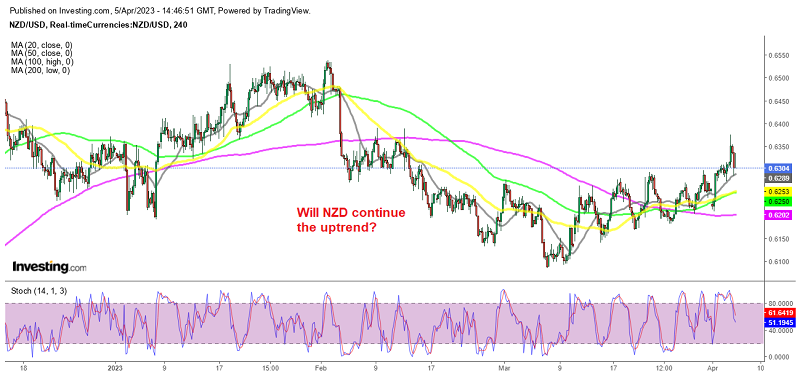Where Is the NZD Left After the 50 bps RBNZ Hike?
The RBNZ raised the cash rate by 50 bps to 5.25%, but the terminal top rate night be revised lower as global economy slows

[[AUD/USD]] retreated lower yesterday despite the weakness in the USD, as the RBA left rates unchanged to 3.60%, although NZD/USD continued the bullish momentum and made further gains as markets were expecting the Reserve Bank of New Zealand (RBNZ) to raise interest rates by 25 basis points in today’s meeting, which would bring the benchmark cash rate to 5.0%. In the past year, the RBNZ has been aggressively tightening rates with some large hikes of 50 and even 75 bps, in an effort to contain inflation.
However, the battle with inflation has been slow, with CPI remaining unchanged at 7.2% in Q4 2022 compared to the third quarter. The New Zealand economy has been hit hard by the sharp rise in rates and weak global demand. The GDP shrank by 0.6% in Q4 2022, and the cyclone in February is expected to have a negative impact on GDP for Q1 as well.
Given this, the RBNZ should take a break from its relentless rate hikes in the upcoming meetings after today’s 50 bps hike. In February, the RBNZ projected a terminal rate of 5.50%, but with the economy showing signs of strain, the central bank may end the tightening cycle at 5.25%, especially if inflation starts to trend downward. There is even a possibility of a rate cut before the end of the year.
Although, with the FED getting also closer to the terminal rate, the drag on the USD should continue, which would be bullish for this pair. So, with downside risks growing to the 5.50% terminal rate for the RBNZ, I think the uptrend in this pair will be slow, if it continues.
Reserve Bank of New Zealand Rate Decision
- RBNZ +50bp rate hike vs. +25bp widely expected
- The committee discussed 25 and 50 basis point increases at this meeting
- Committee was comfortable that current lending rates faced by businesses and households will help ensure core inflation and inflation expectations begin to moderate
- Committee is expecting to see a continued slowing in domestic demand and a moderation in core inflation and inflation expectations
- The extent of this moderation will determine the direction of future monetary policy
- Members noted the rapid pace and extent of tightening to date implies monetary policy is now contractionary
- Committee agreed it must continue to increase the official cash rate (OCR) to return inflation to the 1-3 percent target and to fulfil its remit
- Committee agreed that the full impact of this monetary tightening is yet to be fully realised
- Committee members observed that inflation is nevertheless still too high and persistent
- Members viewed the risks to inflation pressure from fiscal policy as skewed to the upside
- Economic growth in New Zealand is anticipated to slow through 2023
- New Zealand’s banks are well capitalised, profitable, and have strong liquidity positions, with plenty of cash on hand
- Rebuilding following recent extreme weather events will provide a boost to activity and inflation
- Committee’s assessment is that there is no material conflict between lowering inflation and maintaining financial stability in New Zealand
- Economy is starting from a slightly weaker position than assumed in the February statement
- However, demand continues to outpace supply
- Over the medium-term, the inflationary impacts of recent severe weather events are likely to be somewhat larger than assumed at the time of the February statement
- Labour market remains strong, with employment continuing to expand
NZD/USD Live Chart
- Check out our free forex signals
- Follow the top economic events on FX Leaders economic calendar
- Trade better, discover more Forex Trading Strategies
- Open a FREE Trading Account



